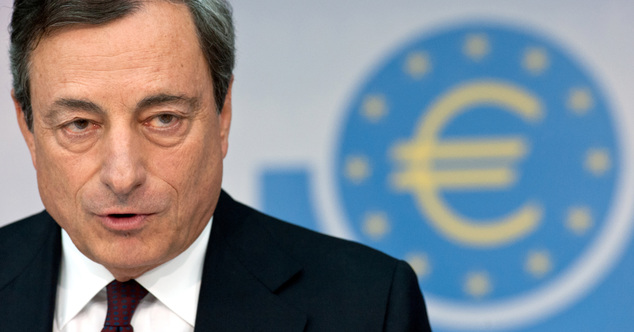in caricamento ...
ALERT: DRAGHI trasforma la BCE in una banca centrale stile FED
 Non vi sto prendendo in giro, anzi. Il discorso di Mario Draghi, appena concluso, non è il solito racconto del menestrello incantatore dei mercati. Questa volta si può trovare un qualcosa di veramente diverso ed importante. Non si parla solo di politica monetaria. Ne parlano tutti e lo stesso Draghi a volte ne abusa perfino. Si tratta in un vero CAMBIO DI TARGET di politica monetaria. Il discorso di Draghi lo potrete trovare QUI.
Non vi sto prendendo in giro, anzi. Il discorso di Mario Draghi, appena concluso, non è il solito racconto del menestrello incantatore dei mercati. Questa volta si può trovare un qualcosa di veramente diverso ed importante. Non si parla solo di politica monetaria. Ne parlano tutti e lo stesso Draghi a volte ne abusa perfino. Si tratta in un vero CAMBIO DI TARGET di politica monetaria. Il discorso di Draghi lo potrete trovare QUI.
[…] This means that it is now changes in the size and composition of our balance sheet that determine our monetary policy stance – or to be more specific, the markets in which we intervene, and the magnitude and pace of our purchases. We expect such interventions to affect output and inflation through two main channels. […]
E’ chiarissimo, gli obiettivi di politica monetaria STANNO CAMBIANDO. E’ un primo passo fondamentale per trasformare la BCE ad una banca centrale più simile alla FED. Non solo inflazione (che tra l’altro non sta assolutamente dirigendo verso l’area 2% in quanto, come illustrato stamattina siamo ben lontani da quell’area) ma anche crescita eocnomica, cercando di comprimere all’ennesima potenza i tassi di mercato con l’obiettivo… TA-DAAANN.. di far spostare gli investitori su asset a più alto rischio come equity e mercato immobiliare.
[…] As we buy assets, investors are likely to substitute the lower risk assets we buy with riskier assets such as longer-term assets, equities and possibly real estate. This has well-known effects on interest rates across the curve, on the cost of capital, on wealth – via higher equity and real estate prices – and therefore on balance sheets more generally. […]
E se avete ancora dubbi, eccovi le conclusioni:
[…] In short, there is a combination of policies that will work to bring growth and inflation back on a sound path, and we all have to meet our responsibilities in achieving that. For our part, we will continue to meet our responsibility – we will do what we must to raise inflation and inflation expectations as fast as possible, as our price stability mandate requires of us.
If on its current trajectory our policy is not effective enough to achieve this, or further risks to the inflation outlook materialise, we would step up the pressure and broaden even more the channels through which we intervene, by altering accordingly the size, pace and composition of our purchases. […]
Quindi sempre monitorare l’inflazione e portarla al 2%, Ma si lavora anche per la crescita economica. Non lo dice ma qui ci sarebbe stato bene anche un “whatever it takes”…nel senso che poi Draghi dichiara apertamente che comprerà a man bassa assett di tutti i tipi.
E’ la consacrazione della nuova BCE, in stile FED
Riproduzione riservata
STAY TUNED!
(Clicca qui per ulteriori dettagli)
Segui @intermarketblog
(Se trovi interessante i contenuti di questo articolo, condividilo ai tuoi amici, clicca sulle icone sottostanti, sosterrai lo sviluppo di I&M!). E se lo sostieni con una donazione, di certo non mi offendo…
La nuova guida per i tuoi investimenti. Take a look!
Questo post non è da considerare come un’offerta o una sollecitazione all’acquisto. Informati presso il tuo consulente di fiducia. Se non ce l’hai o se non ti fidi più di lui,contattami via email (intermarketandmore@gmail.com).
NB: Attenzione! Leggi il disclaimer (a scanso di equivoci!)
Condivido Idlproc, andranno ancora un poco su equity e bond, tanto per sostenere il rally natalizio, e poi?
Bolle sempre più grosse
Comincia a diventarmi simpatico pure Weidmann
è un giorno storico… almeno altri due anni di gonfiaggio e poi…BOOOM!!!
Mi sembra che fai una fuga in avanti, perchè la Bce è soggetta ad uno statuto, che per permettere di compiere alcune azioni stile Fed, deve essere cambiato, e in quel caso occorre il consenso di tutti, compreso i tedeschi ….. E quindi qualsiasi dichiarazione possa fare la creatuta mitico leggendaria che sta a capo della Bce, deve passare al vaglio della sostenibilità dello statuto. Per la cronaca l’eventuale acquisto di titoli di stato dovrebbe essere fatta pro quota, e quindi se non erro ancora una volta favorirebbe i panzer giallo-rosso-neri …… Poi stiamo stranquilli, domnani Weidmann dirà che abbiamo capito tutti male ….
e comunque non si intravede nessun possibile collegamento con l’economia reale!!!!!
Non mi risulta che le politiche monetarie abbiamo creato posti di lavoro; se non intervengono INVESTIMENTI pubblici e privati a sostenere l’economia si finisce per avere un’altra bolla.
E non dimentichiamo che l’intervento della Banca cinese odierno serve per aiutare le banche locali anch’esse piene di crediti Junk…
Secondo me si deve aspettare ancora un po’ e poi conviene uscire gradualmente….aiuti alle famiglie?ma dove sta scritto che l attuale tenore di vita debba essere mantenuto? Dove sta scritto che un bimbo di 10 anni debba avere l iPhone, che si debba cambiare macchina ogni 5 anni, che si debbano mangiare le fragole a gennaio? Ci fanno credere che debba essere così perché’ si deve mantenere il gioco, e via di debito…io credo che il fatto che le banche concedano meno credito sia un bene, sia alle famiglie ( ritorno ad uno stile di vita più’ consono alle condizioni reali) sia alle imprese ( siamo tutti imprenditori, bello essere padroni di se stessi e quanti si improvvisano tali, la realtà’ e’ che tutto questo spazio nn c’è )…ci si vuole aggrappare ad un mondo ed uno stile di vita che nn ha senso, il debito ha gonfiato una crescita troppo veloce e piena di sperequazioni sociali…ma cmq alla fine i conti devono quadrare…ergo basta indebitamento e riforme strutturali per far funzionare le macchine statali e meno gente che guadagna senza lavorare ( apparato statale in primis)… Io credo si debba accettare l idea che europa e USA sono al momento al picco come stile di vita e permettere al l’economia asiatica/russa/africana di crescere, altrimenti nn andiamo da nessuna parte…
Concetti onesti espressi con grande semplicità, ai quali mi associo ….. I miei genitori che purtroppo non ci sono più, anche loro facevano qualche debito , .. a parte che lo facevano per comprare cose utili, ma prima di farne un’altro doveva essere estinto quello precedente, altrimenti si tirava …. e si rinunciava .. Oggi si fanno debiti per pagarne altri per mantenere uno stile di vita non sostenibile . … fino ad arrivare ben oltre il picco a cui fai riferimento, grazie proprio a quella montagna di debiti che prima o poi …..
THE DUAL BANKING SYSTEM (versus) – Part l
l-1-l J. Weidmann (Deutsche Bundesbank, President), [Speech] “Banking union and regulatory reforms – mission accomplished?” – [at the] 24th Frankfurt European Banking Congress, Frankfurt am Main: November 21, 2014
…” One of the core elements of the new resolution framework will be the BAIL-IN regime.
It sets out a clear liability cascade for failing banks.
In future, investors will be first in line to shoulder the costs of bank failures – and rightfully so, since they were the ones that assumed the risks and benefited from the returns in the first place.
An essential requirement for the credibility of the BAIL-IN regime is the existence of sufficient BAIL-IN-able capital.
In this regard, the G20 leaders’ decision to endorse the Financial Stability Board’s proposal to introduce a Total Loss Absorbing Capacity (TLAC) for Global Systemically Important Banks (G-SIBs) at their meeting in Brisbane a few days ago marks an important step forward.
According to the FSB proposal, the World’s 30 largest banks will be required to hold TLAC in a range of 16-20% of their risk-weighted assets and 6% of their unweighted assets.
The implementation of the TLAC will help to mitigate the “too big to fail” [TBTF] problem, which is a particularly relevant topic for G-SIBs.
The TLAC proposal is neutral in terms of banks’ structures.
In order to be able to absorb losses in resolution, TLAC instruments need to be subordinated, regardless whether this is achieved via contractual, statutory or structural subordination.
Moreover, comprehensive studies will be carried out to analyse the potential impact of the TLAC proposal, following which the TLAC requirement will be finalised.
The Euro-area has already introduced a Minimum Requirement for own Funds and Eligible Liabilities (MREL) which applies to all institutions that are covered by the [(EU) Bank Recovery and Resolution Directive] BRRD.
But so far, these liabilities can be held by other financial institutions.
In order to tackle the issue of contagion and thus bolster financial stability, this standard should, however, discourage other financial institutions from holding these liabilities, eg by setting limits or deductions from own funds.
Therefore, I agree in essence with Goethe University’s Jan-Pieter Krahnen(*) who said in an interview with Handelsblatt last week that “bail-in bonds should only be held by institutions […] that are […] able to bear the […] shock of a bank’s insolvency without suffering a run themselves”.
-[ (*) J. P. Krahnen (Handelsblatt, Finanzen & Börsen), “Dafür ist ein Aufseher nicht qualifiziert” – November 10, 2014
(also summary-analysis in
RiskNET, “Regulierung von Asset Backed Securities (ABS) – Transparenz bei ABS-Papieren gefordert” – Oktober 13, 2014
Assuming the BAIL-IN mechanism works in practice, this will also be an important step towards breaking the disastrous sovereign-bank nexus.
However, more will need to be done if we are to overcome this nexus, which became a vicious cycle during the crisis.
In particular, the preferential treatment afforded to sovereign bonds under the Basel III regime needs to be reconsidered.
To quote Danièle Nouy: “sovereigns are not risk-free assets. That has been demonstrated, so now we have to react”.
Putting an end to ZERO risk weighting and particularly applying a large exposures regime to sovereign bonds would trigger substantial repercussions, but these would be manageable if they were phased in over a transitional period – which would undoubtedly need to be granted. “…
http://www.bundesbank.de/Redaktion/EN/Reden/2014/2014_11_21_weidmann.html .
サーファー © Surfer [to be continued…]
THE DUAL BANKING SYSTEM (versus) – Part ll
l-2-l D. K. Tarullo (Federal Reserve S-Y-S-T-E-M, Member of the Board of Governors), [Speech] “Liquidity regulation” – [at the] Clearing House 2014 Annual Conference, New York City: November 20, 2014
see (W-E-L-L) to
l-§-l Bank liquidity regulation and supervision, Pp. 11-17 (or 11-18/ 21)
http://www.federalreserve.gov/newsevents/speech/tarullo20141120a.pdf !.!.!
l- – – – –
Balance sheets of the (“REAL”) Central Bank and the banking system are inter-connected.
The (“REAL”) Central Bank’s ASSETS [Net Foreign Assets (NFA); Domestic Assets (DA): (i) government securities, (ii) loans to commercial banks, (iii) other domestic assets] consist of foreign currency and domestic assets, while its LIABILITIES [Monetary Liabilities: (i) currency in circulation, (ii) banking system’s reserves; Non-Monetary liabilities: (i) central bank securities, (ii) others, (iii) equity capital] comprise currency, banking system’s reserves, securities, other liabilities and equity capital.
The currency and banking system’s reserves are monetary liabilities, while the other items in the liability side are non-monetary liabilities. Of these, currency is largely determined by PUBLIC’s DEMAND for cash balances, and equity capital represents government transfers to the (REAL) Central Bank.
The remaining liabilities are within the control of the (REAL) Central Bank.
In the balance sheet of the (REAL) Central Bank, without increase in equity capital, the accumulation of foreign currency reserves requires a financing in some forms which increase other liabilities.
The monetary liabilities are also considered as Central Bank liquidity, which the (REAL) Central Bank can create through its operations.
Any increase (or decrease) in (REAL) Central Bank’s assets can create (or destroy) the (REAL) Central Bank liquidity in PARALLEL.
Any transaction between the banking system and the (REAL) Central Bank creates (or destructs) money-market liquidity which increases (or decreases) the banking system’s reserve balances with the (REAL) Central Bank.
This reserve balance is an important component of the (REAL) monetary “BASE”.
– – – – -l
The end result – Parts l-&-ll – is:
l-1-l /+ (or versus -)/ l-2-l = (miSSion) IM-POSSIBLE .!.!.
It’s easier for a camel to pass through the eye of a needle than (I/We/They) see the Mr. President Draghi make [to] the single European central banker (“BASE”) – [ignoring the legal statutes and the “Beatitudes”, of course].
サーファー © Surfer [“Surfer from in-Side” – Ps: excellent(S) Vito_t and Overshooting. I quote to You]
Mariuccio puo’ fare questo, e molto di piu’….per esempio rivolgere le sue amorevoli cure ancora una volta verso l’italia, che deve svendere al piu’ presto le aziende strategiche
http://www.repubblica.it/economia/2014/11/22/news/bce_in_rivolta_le_banche_di_nuovo_sotto_esame-101140657/
(cvd, alias QED)
…” De Madrid al cielo y un agujerito para verlo “…
– – – ” In the interest of a more prosperous monetary union, at times national sensitivities have to be put aside. ” – – –
J. Weidmann (Deutsche Bundesbank, President), [Speech] “Towards a more prosperous monetary union”, [at the] Asociación de Mercados Financieros (AMF, ACI España): Convención Anual Financiera 2014 – Madrid: November 24, 2014
http://www.bundesbank.de/Redaktion/EN/Reden/2014/2014_11_24_weidmann.html
Machen sie sich die ruhe des geistes – er sagt und wiederholt immer.
…” Nichts Quantitativen Lockerung “… – qed: QnEin!
サーファー © Surfer [Fur diejenigen, die nicht wollen, um zu verstehen: immer wiederholt … QED, alias cvd]
[Gli ormai famosi] “Märkte Sturmtruppen”,
DOPO CHE per mesi, settimane, giorni, ore (ossia, anche stamane – nell’Emisfero Boreale) avevano previsto-predetto [con la L-O-R-O consueta sfera di cristallo – tipica delle/dei maghe/maghi SUPER farlocche/farlocchi] l’IMMINENTE messa in atto e/od opera da parte del Board dell’ECB del cd. Quantitative Easing (QE),
fanno sapere al pOpO_linO (Italico) quanto segue:
Constancio (Bce), sul QE si deciderà nel primo trimestre
…^ “Nel primo trimestre – spiega Constancio – saremo in grado di fare una valutazione più appropriata”.
Non sarà quindi dato il via al QE nella riunione del 4 dicembre, come invece qualcuno cominciava a credere, -[OSSIA, PROPRIO L-O-R-O e CON TUTTI i L-O-R-O “emeriti maghi” – e le relative “sfere”]- viste le più recenti dichiarazioni del presidente della Bce, Mario Draghi. ^…
AMEN – “alle facce e alle palle”.
サーファー © Surfer [Essendo dei “Märkte Sturmtruppen”, da domani rinizieranno la tiritera (arriba, arriba il QE, il prossimo anno) -; le Agenzie o Società di betting, quotano fin da ora l'”all-in”]




Penso che il “risultato” del’operazione resterà interno al sistema finanziario, con qualche bolla aggiuntiva. Probabile che però non abbia compreso bene.